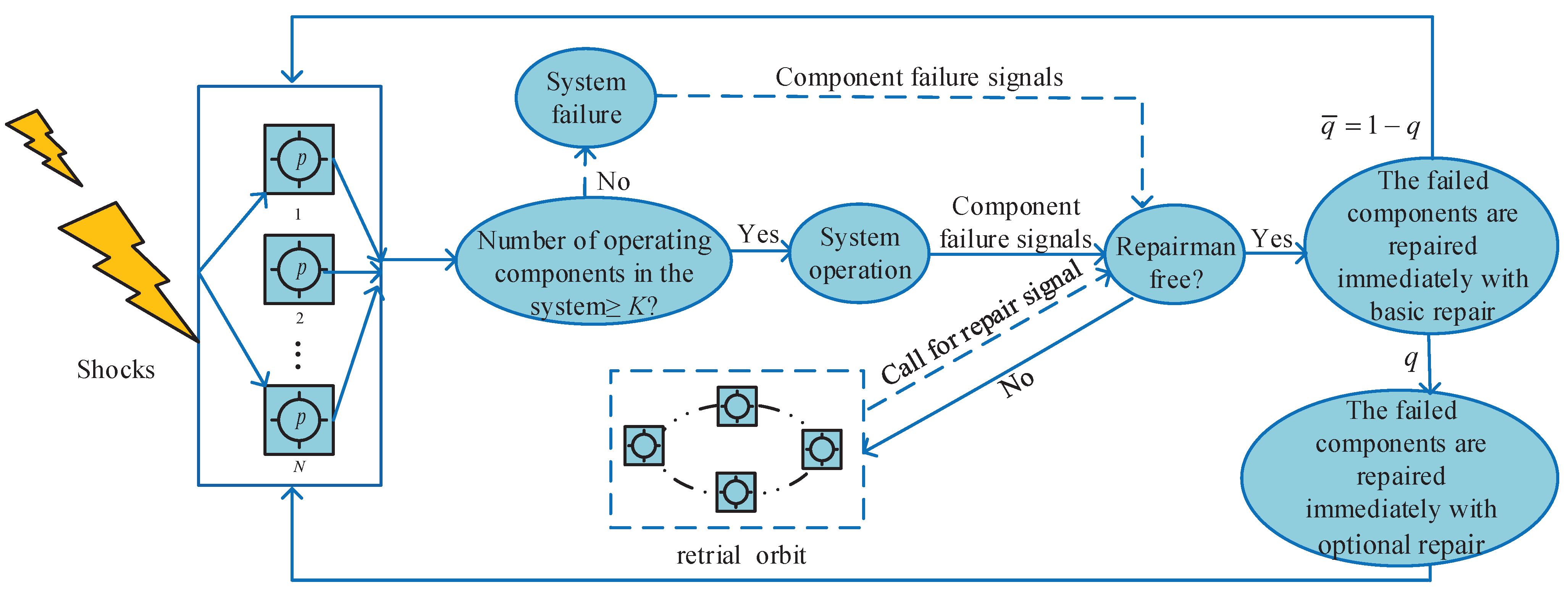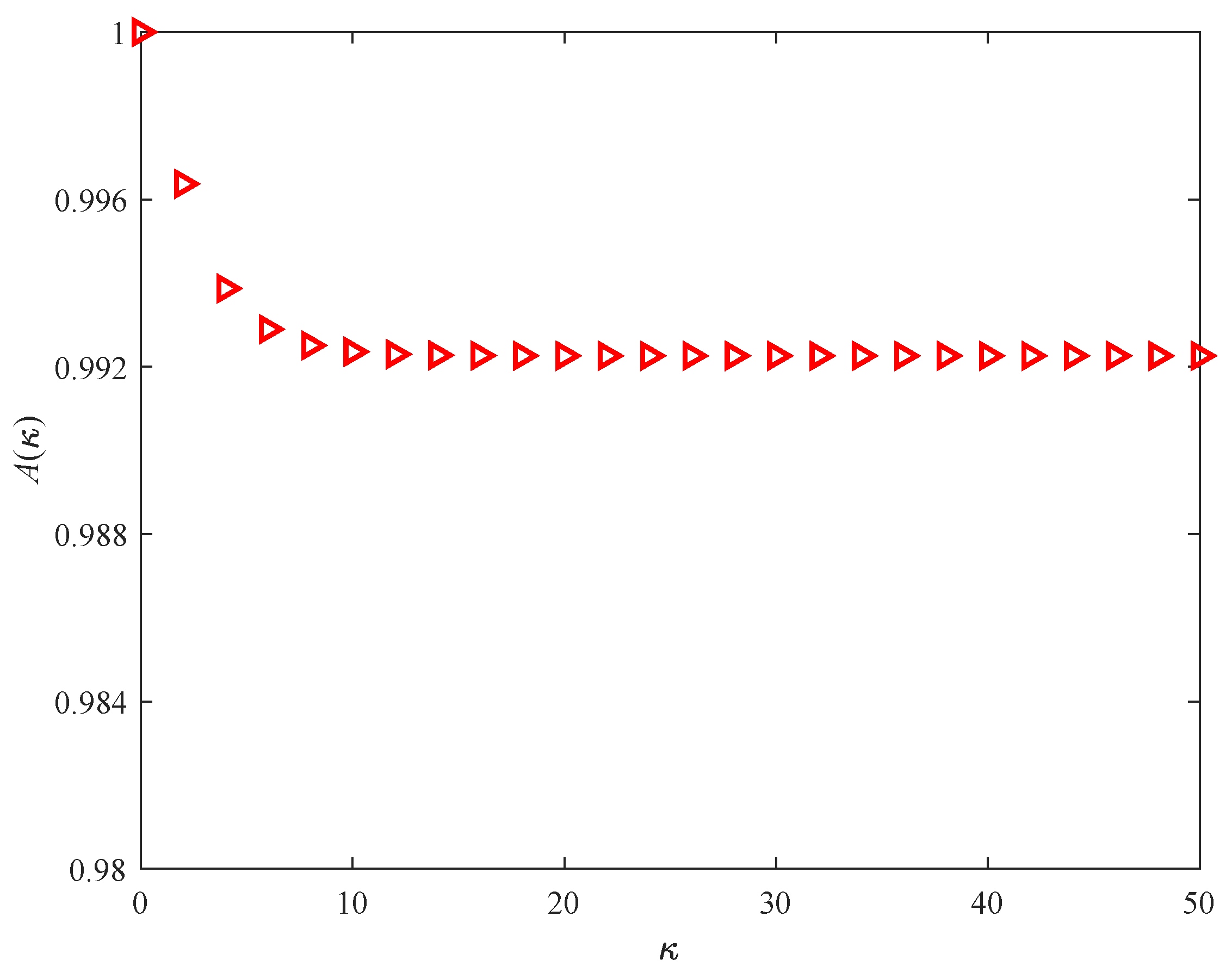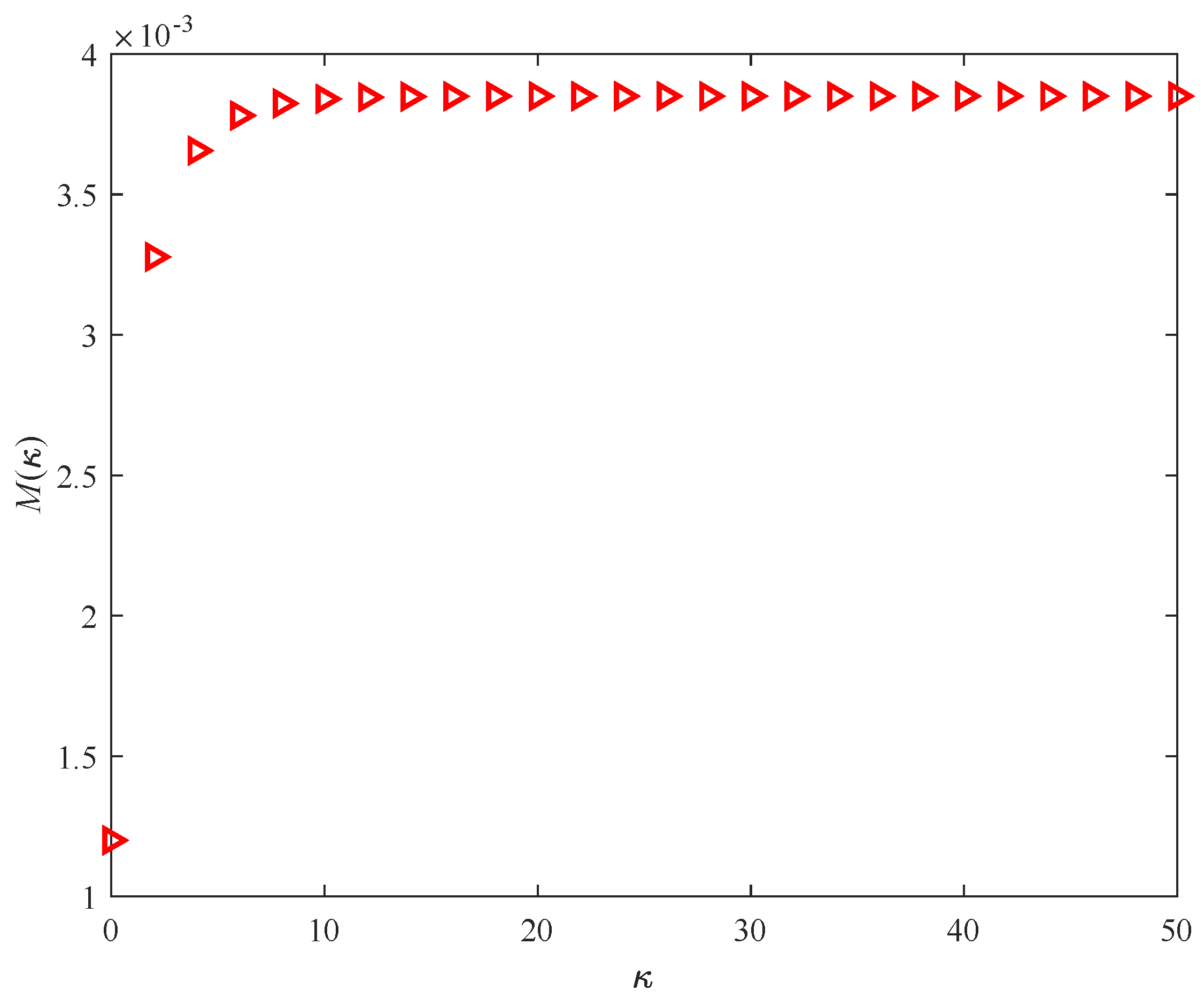Shock Model of K/N: G Repairable Retrial System Based on Discrete PH Repair Time
Abstract
1. Introduction
2. System Model
2.1. Model Description
- (a)
- Shock environment: The system suffers from Bernoulli shock currents (rate ), and the effect on components is independent. The failure threshold is a constant or a random variable, and the shock magnitude is a random variable. Component failure occurs at the time when the shock magnitude is more than the failure threshold.
- (b)
- Failure mechanism: The components fail due to two factors: external shocks and their lifetime. These two factors could lead to multiple component failures at once. The lifetime of the component is assumed to be geometrically distributed with parameter p. The impact of lifetime upon the components can be ignored when a shock arrives.
- (c)
- Repair mechanism: The failed component is repaired by a repairman who provides a two-stage repair service: basic repair and optional repair. After the completion of the basic repair, the component is repaired in an optional repair with probability q, or leaves the service desk with probability . Repair times for the two stages are different m-order discrete PH distributions, respectively expressed as , , , and , .
- (d)
- Retrial rule: When the repairman is busy, the newly failed component enters the retrial orbit and retries repeatedly to obtain repair according to FIFO rules. The retrial time is geometrically distributed with parameter .
- (e)
- Priority rule: (1) The following order of occurrence is specified when multiple events occur simultaneously: the component failure, the failed component retrial and the repair completion (any stage of repair). (2) The failure information of components is retrieved one by one when multiple components fail simultaneously, and the component retrieved first has priority for repair or joining the retrial orbit.
2.2. Discrete Time Markov Process
- System state analysis
- (1)
- : there are no failed components in the system.
- (2)
- : there are s failed components in the system.
- (3)
- : there are N failed components in the system.
- One-step transition probability
2.3. Transition Probability Matrix
3. Reliability Indexes
3.1. System Availability and Failure Condition Probability in Transient State
- The system transient-state availability
| Algorithm 1: Solution of the system transient-state availability |
Input: N, K, m, , , , , , q, , , , , , , Output: System transient-state availability Procedure: 1: Given the the one-step transition probability matrix L and its block matrices; 2: Assign F as an identity matrix of order ; 3: Compute ; 4: Initialize ; 5: Step 1: Compute ; for do 1.1.Update = ; 1.2.Update ; end 6: Step 2: Compute ; for do for do 2.1.Update ; 2.2.Update ; end end 7: Step 3: Compute ; for do for do 3.1.Update ; 3.2.Update ; end end 8: Final step: sum results. . |
- Failure conditional probability in transient state
3.2. System Availability and Failure Condition Probability in Steady State
- System availability in steady state
- Failure condition probability M in steady state
| Algorithm 2: Solution of the system failure conditional probability |
Input: N, K, m, , , , , , q, , , , , , , Output: Failure conditional probability in transient state 1: Given the the one-step transition probability matrix L and its block matrices; 2: Assign F, I and R as identity matrices of order , and respectively; 3: ; 4: ; for do = ; ; ; end 5: ; for do for do ; ; ; end end 6: ; for do for do ; ; ; end end 7: . |
- Steps for solving the steady-state probability vectors and
- (i)
- Establishment of steady-state probability equation
- (ii)
- Decomposition of steady-state probability equation
- (iii)
- Solution of the steady-state probability equation
| Algorithm 3: Solution of steady-state probability vectors , and M |
Input: N, K, m, , , , , q, , , , , , , Output: , , M 1: Obtain the one-step transition probability matrix L and its block matrices; and do the following 2: ; 3: ; 4: ; 5: ; 6: ; ) 7: ; 8: ; 9: ; 10: ; 11: ; 12: ; ; ; ; ; Calculate based on Equation (7) 13: ; Calculate based on Equation (8) 14: for do ; end 15: ; for do ; ; end 16: ; 17: return , , M. |
4. Numerical Example
5. Conclusions
Author Contributions
Funding
Data Availability Statement
Conflicts of Interest
Appendix A. The Sub-Blocks of the Matrix L
- The transition probability matrices and for the transition of to each state set are as follows:
- The transition probability matrices and for the transition of to each state set are as follows:
- The transition probability matrices and for the transition of to each state set are as follows:
- The transition probability matrices and for the transition of to each state set are as follows:
- The transition probability matrices and for the transition of to each state set are as follows:
- The transition probability matrices and for the transition of to each state set are as follows:
References
- Esary, J.D.; Marshall, A.W.; Proschan, F. Shock models and wear processes. Ann. Probab. 1973, 1, 627–649. [Google Scholar] [CrossRef]
- Gut, A.; Hüsler, J. Realistic variation of shock models. Stat. Probabil. Lett. 2005, 74, 187–204. [Google Scholar] [CrossRef]
- Montoro-Cazorla, D.; Pérez-Ocón, R. A reliability system under cumulative shocks governed by a BMAP. Appl. Math. Model. 2015, 39, 7620–7629. [Google Scholar] [CrossRef]
- Wu, B.; Cui, L.; Yin, J. Reliability and maintenance of systems subject to Gamma degradation and shocks in dynamic environments. Appl. Math. Model. 2021, 96, 367–3812. [Google Scholar] [CrossRef]
- Mallor, F.; Omey, E. Shocks, runs and random sums. J. Appl. Probab. 2001, 38, 438–448. [Google Scholar] [CrossRef]
- Ozkut, M.; Eryilmaz, S. Reliability analysis under Marshall-Olkin run shock model. J. Comput. Appl. Math. 2019, 349, 52–59. [Google Scholar] [CrossRef]
- Eryilmaz, S. δ-shock model based on Polya process and its optimal replacement policy. Eur. J. Oper. Res. 2017, 263, 690–697. [Google Scholar] [CrossRef]
- Lorvand, H.; Nematollahi, A.; Poursaeed, M.H. Life distribution properties of a new δ-shock model. Commun. Stat.-Theor. Methods 2020, 49, 3010–3025. [Google Scholar] [CrossRef]
- Cirillo, P.; Hüsler, J. Extreme shock models: An alternative perspective. Stat. Probabil. Lett. 2011, 81, 25–30. [Google Scholar] [CrossRef]
- Eryilmaz, S.; Kan, C. Reliability and optimal replacement policy for an extreme shock model with a change point. Reliab. Eng. Syst. Saf. 2019, 190, 106513. [Google Scholar] [CrossRef]
- Barron, Y.; Frostig, E.; Levikson, B. Analysis of R out of N systems with several repairmen, exponential life times and phase type repair times: An algorithmic approach. Eur. J. Oper. Res. 2006, 169, 202–225. [Google Scholar] [CrossRef]
- Yuan, L. Reliability analysis for a k-out-of-n: G system with redundant dependency and repairmen having multiple vacations. Appl. Math. Comput. 2012, 218, 11959–11969. [Google Scholar] [CrossRef]
- Zhao, X.; Wu, C.; Wang, S.; Wang, X. Reliability analysis of multi-state k-out-of-n: G system with common bus performance sharing. Comput. Ind. Eng. 2018, 124, 359–369. [Google Scholar] [CrossRef]
- Gao, H.; Cui, L.; Yi, H. Availability analysis of k-out-of-n: F repairable balanced systems with m sectors. Reliab. Eng. Syst. Saf. 2019, 191, 106572. [Google Scholar] [CrossRef]
- Eryilmaz, S.; Devrim, Y. Reliability and optimal replacement policy for a k-out-of-n system subject to shocks. Reliab. Eng. Syst. Saf. 2019, 188, 393–397. [Google Scholar] [CrossRef]
- Wang, X.; Ning, R.; Zhao, X.; Zhou, J. Reliability analyses of k-out-of-n: F capability-balanced systems in a multi-source shock environment. Reliab. Eng. Syst. Saf. 2022, 227, 108733. [Google Scholar] [CrossRef]
- Neuts, M.F. Matrix-Geometric Solutions in Stochastic Models: An Algorithmic Approach; Johns Hopkins University Press: Baltimore, MD, USA, 1981. [Google Scholar]
- Ruiz-Castro, J.E.; Pérez-Ocón, R.; Fernández-Villodre, G. Modelling a reliability system governed by discrete phase-type distributions. Reliab. Eng. Syst. Saf. 2008, 93, 1650–1657. [Google Scholar] [CrossRef]
- Ruiz-Castro, J.E.; Fernández-Villodre, G.; Pérez-Ocón, R. A multi-component general discrete system subject to different types of failures with loss of units. Discrete. Event. Dyn. Syst. 2009, 19, 31–65. [Google Scholar] [CrossRef]
- Kan, C.; Eryilmaz, S. Reliability assessment of a discrete time cold standby repairable system. TOP 2021, 29, 613–628. [Google Scholar] [CrossRef]
- Ruiz-Castro, J.E.; Fernández-Villodre, G. A complex discrete warm standby system with loss of units. Eur. J. Oper. Res. 2012, 218, 456–469. [Google Scholar] [CrossRef]
- Ruiz-Castro, J.E. Complex multi-state systems modelled through marked Markovian arrival processes. Eur. J. Oper. Res. 2016, 252, 852–865. [Google Scholar] [CrossRef]
- Ruiz-Castro, J.E.; Li, Q. Algorithm for a general discrete k-out-of-n: G system subject to several types of failure with an indefinite number of repairpersons. Eur. J. Oper. Res. 2011, 211, 97–111. [Google Scholar] [CrossRef]
- Ruiz-Castro, J.E. Preventive maintenance of a multi-state device subject to internal failure and damage due to external shocks. IEEE Trans. Reliab. 2014, 63, 646–660. [Google Scholar] [CrossRef]
- Almási, B.; Roszik, J.; Sztrik, J. Homogeneous finite-source retrial queues with server subject to breakdowns and repairs. Math. Comput. Model. 2005, 42, 673–682. [Google Scholar] [CrossRef][Green Version]
- Gharbi, N.; Loualalen, M. GSPN analysis of retrial systems with servers breakdowns and repairs. Appl. Math. Comput. 2006, 174, 1151–1168. [Google Scholar] [CrossRef]
- Boualem, M.; Djellab, N.; Aïssani, D. Stochastic inequalities for M/G/1 retrial queues with vacations and constant retrial policy. Math. Comput. Model. 2009, 50, 207–212. [Google Scholar] [CrossRef]
- Gao, S.; Wang, J. Performance and reliability analysis of an M/G/1-G retrial queue with orbital search and non-persistent customers. Eur. J. Oper. Res. 2014, 236, 561–572. [Google Scholar] [CrossRef]
- Peng, Y.; Liu, Z.; Wu, J. An M/G/1 retrial G-queue with preemptive resume priority and collisions subject to the server breakdowns and delayed repairs. J. Appl. Math. Comput. 2024, 44, 187–213. [Google Scholar] [CrossRef]
- Kuo, C.-C.; Sheu, S.-H.; Ke, J.-C.; Zhang, Z.G. Reliability-based measures for a retrial system with mixed standby components. Appl. Math. Model. 2014, 38, 4640–4651. [Google Scholar] [CrossRef]
- Yen, T.-C.; Wang, K.-H. Cost benefit analysis of four retrial systems with warm standby units and imperfect coverage. Reliab. Eng. Syst. Saf. 2020, 202, 107006. [Google Scholar] [CrossRef]
- Wang, K.-H.; Wu, C.-H.; Yen, T.-C. Comparative cost-benefit analysis of four retrial systems with preventive maintenance and unreliable service station. Reliab. Eng. Syst. Saf. 2022, 221, 108342. [Google Scholar] [CrossRef]
- Li, M.; Hu, L.; Wu, S.; Zhao, B.; Wang, Y. Reliability assessment for consecutive-k-out-of-n: F retrial systems under Poisson shocks. Appl. Math. Comput. 2023, 448, 127913. [Google Scholar] [CrossRef]
- Sanga, S.S.; Charan, G.S. Fuzzy modeling and cost optimization for machine repair problem with retrial under admission control F-policy and feedback. Math. Comput. Simulat. 2023, 211, 214–240. [Google Scholar] [CrossRef]
- Kang, J.; Hu, L.; Peng, R.; Li, Y.; Tian, R. Availability and cost-benefit evaluation for a repairable retrial system with warm standbys and priority. Stat. Theory Relat. Fields 2023, 7, 164–175. [Google Scholar] [CrossRef]
- Xu, W.; Li, L.; Fan, W.; Liu, L. Optimal control of a two-phase heterogeneous service retrial queueing system with collisions and delayed vacations. J. Appl. Math. Comput. 2024, 1–28. [Google Scholar] [CrossRef]
- Madan, K.C. An M/G/1 queue with second optional service. Queueing. Syst. 2000, 34, 37–46. [Google Scholar] [CrossRef]
- Wang, J. An M/G/1 queue with second optional service and server breakdowns. Comput. Math. Appl. 2004, 47, 1713–1723. [Google Scholar] [CrossRef]
- Yang, D.-Y.; Wang, K.-H.; Pearn, W.L. Steady-state probability of the randomized server control system with second optional service, server breakdowns and startup. J. Appl. Math. Comput. 2010, 32, 39–58. [Google Scholar] [CrossRef]
- Wang, J.; Zhao, Q. A discrete-time Geo/G/1 retrial queue with starting failures and second optional service. Comput. Math. Appl. 2007, 53, 115–127. [Google Scholar] [CrossRef][Green Version]
- Kumar, A.; Jain, M. Cost optimization of an unreliable server queue with two stage service process under hybrid vacation policy. Math. Comput. Simulat. 2023, 204, 259–281. [Google Scholar] [CrossRef]
- Gao, S. Availability and reliability analysis of a retrial system with warm standbys and second optional repair service. Commun. Stat.-Theor. Methods 2023, 52, 1039–1057. [Google Scholar] [CrossRef]
- Wang, Y.; Hu, L.; Zhao, B.; Tian, R. Stochastic modeling and cost-benefit evaluation of consecutive k/n: F repairable retrial systems with two-phase repair and vacation. Comput. Ind. Eng. 2023, 175, 108851. [Google Scholar] [CrossRef]
- Yu, X.; Hu, L.; Ma, M. Reliability measures of discrete time k-out-of-n: G retrial systems based on Bernoulli shocks. Reliab. Eng. Syst. Saf. 2023, 239, 109491. [Google Scholar] [CrossRef]
- Hu, Z.; Hu, L.; Wu, S.; Yu, X. Reliability assessment of discrete-time k/n (G) retrial system based on different failure types and the δ-shock model. Reliab. Eng. Syst. Saf. 2024, 251, 110371. [Google Scholar] [CrossRef]



| State Transition | One-Step Transition Probability |
|---|---|
| State Transition | One-Step Transition Probability |
|---|---|
| Indexes | p | ||||
|---|---|---|---|---|---|
| 0.02 | 0.025 | 0.03 | 0.035 | ||
| 5 | 0.9765 | 0.9680 | 0.9596 | 0.9512 | |
| 10 | 0.9728 | 0.9630 | 0.9532 | 0.9436 | |
| 50 | 0.9724 | 0.9625 | 0.9527 | 0.9429 | |
| 100 | 0.9724 | 0.9625 | 0.9527 | 0.9429 | |
| ∞ | 0.9724 | 0.9625 | 0.9527 | 0.9429 | |
| 5 | 0.0087 | 0.0112 | 0.0137 | 0.0161 | |
| 10 | 0.0090 | 0.0115 | 0.0140 | 0.0165 | |
| 50 | 0.0090 | 0.0116 | 0.0141 | 0.0165 | |
| 100 | 0.0090 | 0.0116 | 0.0141 | 0.0165 | |
| ∞ | 0.0090 | 0.0116 | 0.0141 | 0.0165 | |
| Indexes | |||||
|---|---|---|---|---|---|
| 0.01 | 0.015 | 0.02 | 0.025 | ||
| 5 | 0.9765 | 0.9680 | 0.9596 | 0.9512 | |
| 10 | 0.9728 | 0.9630 | 0.9532 | 0.9436 | |
| 50 | 0.9724 | 0.9625 | 0.9527 | 0.9429 | |
| 100 | 0.9724 | 0.9625 | 0.9527 | 0.9429 | |
| ∞ | 0.9724 | 0.9625 | 0.9527 | 0.9429 | |
| 5 | 0.0087 | 0.0112 | 0.0137 | 0.0161 | |
| 10 | 0.0090 | 0.0115 | 0.0140 | 0.0165 | |
| 50 | 0.0090 | 0.0116 | 0.0141 | 0.0165 | |
| 100 | 0.0090 | 0.0116 | 0.0141 | 0.0165 | |
| ∞ | 0.0090 | 0.0116 | 0.0141 | 0.0165 | |
| Indexes | |||||
|---|---|---|---|---|---|
| 0.8 | 0.85 | 0.9 | 0.95 | ||
| 5 | 0.9763 | 0.9764 | 0.9765 | 0.9765 | |
| 10 | 0.9726 | 0.9725 | 0.9728 | 0.9730 | |
| 50 | 0.9718 | 0.9722 | 0.9724 | 0.9727 | |
| 100 | 0.9718 | 0.9722 | 0.9724 | 0.9727 | |
| ∞ | 0.9718 | 0.9722 | 0.9724 | 0.9727 | |
| 5 | 0.00875 | 0.00874 | 0.00873 | 0.00872 | |
| 10 | 0.009018 | 0.009006 | 0.008986 | 0.008968 | |
| 50 | 0.009072 | 0.009044 | 0.009019 | 0.008997 | |
| 100 | 0.009072 | 0.009044 | 0.009019 | 0.008997 | |
| ∞ | 0.009072 | 0.009044 | 0.009019 | 0.008997 | |
| N | M | |
|---|---|---|
| 10 | 0.5648 | 0.1045 |
| 15 | 0.9645 | 0.0080 |
| 20 | 0.9813 | 0.0042 |
| 25 | 0.982274 | 0.003987 |
| 30 | 0.982287 | 0.003984 |
Disclaimer/Publisher’s Note: The statements, opinions and data contained in all publications are solely those of the individual author(s) and contributor(s) and not of MDPI and/or the editor(s). MDPI and/or the editor(s) disclaim responsibility for any injury to people or property resulting from any ideas, methods, instructions or products referred to in the content. |
© 2024 by the authors. Licensee MDPI, Basel, Switzerland. This article is an open access article distributed under the terms and conditions of the Creative Commons Attribution (CC BY) license (https://creativecommons.org/licenses/by/4.0/).
Share and Cite
Yu, X.; Hu, L.; Hu, Z. Shock Model of K/N: G Repairable Retrial System Based on Discrete PH Repair Time. Axioms 2024, 13, 814. https://doi.org/10.3390/axioms13120814
Yu X, Hu L, Hu Z. Shock Model of K/N: G Repairable Retrial System Based on Discrete PH Repair Time. Axioms. 2024; 13(12):814. https://doi.org/10.3390/axioms13120814
Chicago/Turabian StyleYu, Xiaoyun, Linmin Hu, and Zebin Hu. 2024. "Shock Model of K/N: G Repairable Retrial System Based on Discrete PH Repair Time" Axioms 13, no. 12: 814. https://doi.org/10.3390/axioms13120814
APA StyleYu, X., Hu, L., & Hu, Z. (2024). Shock Model of K/N: G Repairable Retrial System Based on Discrete PH Repair Time. Axioms, 13(12), 814. https://doi.org/10.3390/axioms13120814





